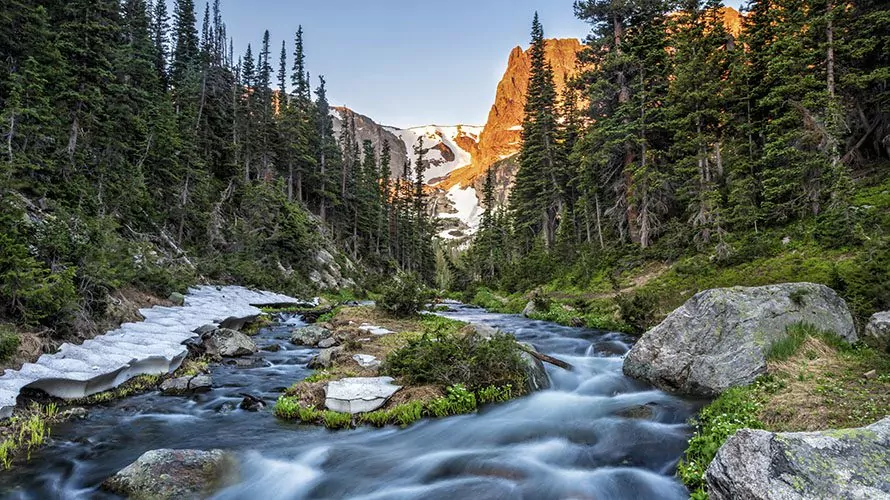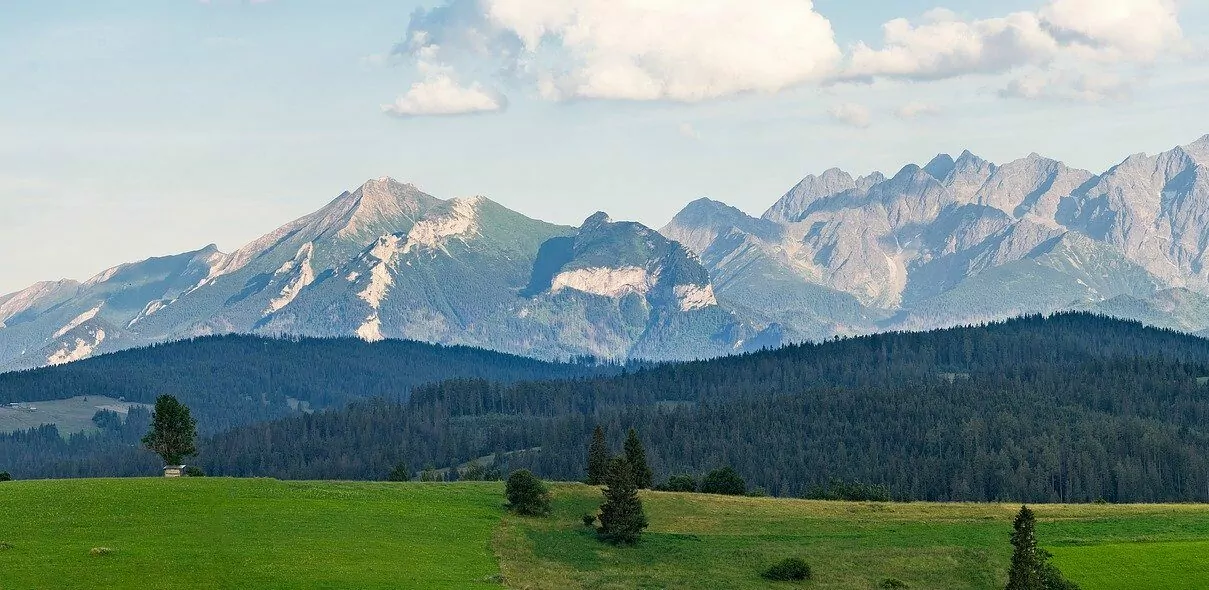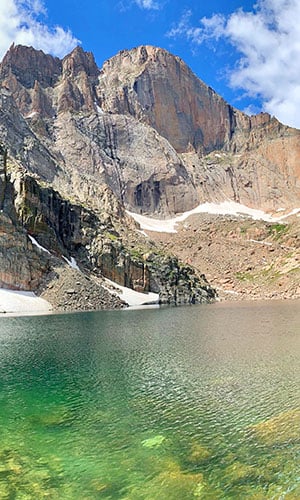Best Hikes in Rocky Mountain National Park
Guide to choosing the right hike for you
There are so many things that you can’t see from the road in Rocky Mountain National Park—you have to get out on foot to truly experience the majesty of this park! With 355 miles of hiking trails, there is something for everyone to enjoy; whether you fancy cascading waterfalls, pristine alpine lakes, glacier-carved cirques, views of mountains for miles and miles, or meadows covered in wildflowers. Trails range in distance and difficulty, so you will be able to find a trail suited for your interests and abilities—beginners and veterans alike.
Below, we have highlighted our 12 favorite hikes in Rocky Mountain. The list is not comprehensive, visit the National Park Service for more trails. And always check the trail conditions when planning your trip.

1. Dream lake
- Trailhead: Bear Lake Trailhead
- Distance (roundtrip): 2.2 miles
- Elevation Gain: 425 feet
Just past the trailhead, the Bear Lake Loop continues to the right, and the trail to Dream Lake splits to the left. After a steady climb, you will reach Nymph Lake, covered in lily pads, at a half mile. As you round the lake, and climb for one short section more, you will come into perfect view of Longs Peak in the distance. Continue, and after 1.1 miles total, you will reach the banks of Dream Lake; it’s name is very fitting, as you have views of Hallett Peak at 12,713 feet, and Flattop Mountain at 12,324 feet.
This hike is great for those who just arrived in the Rockies, as it is short and sweet, with not too much elevation gain, and allows your lungs and legs to get used to the altitude. Dream Lake is also a great sunrise destination—you’ll experience these behemoth granite peaks ablaze with the day’s first light.
2. emerald lake
- Trailhead: Bear Lake Trailhead
- Distance (roundtrip): 3.6 miles
- Elevation Gain: 605 feet
Emerald Lake is a refreshing day hike into the mountains, and you are rewarded with spectacular views of Tyndall Glacier, Hallett Peak and Flattop Mountain. Continue on the Bear Lake Trail, to Dream Lake, as described above. Once at Dream Lake, follow the trail around the north shore of the lake, traveling further in the Tyndall Gorge. At 1.8 miles, you will reach Emerald Lake, with the impressive view of Hallett Peak directly in front of you, and Flattop Mountain to the right. This is an out-and-back hike, so when you are ready, start back down the trail the way you came.
3. odessa lake
- Trailhead: Bear Lake Trailhead
- Distance (roundtrip): 8.9 miles
- Elevation Gain: 1900 feet
The trail to Odessa Lake begins at the Bear Lake Trailhead, and immediately you will take a right, following signs for Odessa Lake and Flattop Mountain. In route, you will pass through a shimmering aspen grove, and have tremendous views of Longs Peak, the Keyboard of the Winds, Chiefs Head Peak and Pagoda Peak. There will be many junctions along the way, always follow the signs and stay on the trail to Odessa Lake. At 3.6 miles, you will reach a side trail for Lake Helene, a beautiful alpine lake which provides phenomenal views of Notchtop Mountain. After a brief detour to Lake Helene, continue on the main trail to Odessa Lake. You will reach the banks of the lake at 4.3 miles. Odessa Lake is incredible, and the surrounding mountains are stunning.
You can complete the trail to Odessa Lake as an out-and-back, or you can finish the trail at Fern Lake Trailhead (information below). A great way to see the entirety of Odessa Gorge is if you start at Bear Lake Trailhead and hike through to Fern Lake Trailhead. The free park shuttle bus can take you from Fern Lake Trailhead back to your car at Bear Lake Trailhead, or vice versa.
4. fern lake
- Trailhead: Fern Lake Trailhead
- Distance (roundtrip): 7.6 miles
- Elevation Gain: 1375 feet
The trail to Fern Lake follows the Big Thompson River, and you will get a variety of landscapes including meadows, forests and wildflowers. At 1.7 miles, the Big Thompson River will merge with the Fern Creek, it’s confluence creating The Pool, which is a nice spot for a snack. Just beyond The Pool is a steep side trail that leads to Fern Falls, an impressive 60 foot waterfall. The trail continues, and at 3.8 miles, you will reach Fern Lake, offering great views of Little Materhorn, the Gables, Notchtop Mountain and Knobtop Mountain. Fishing is a very popular activity at Fern Lake, where cutthroat trout live in abundance. This is an out-and-back hike—so once you are ready, simply retrace your steps back to the trailhead.
5. alberta falls & mills lake
- Trailhead: Glacier Gorge Junction
- Distance (roundtrip): 5.5 miles
- Elevation Gain: 750 feet
Hiking to Alberta Falls and Mills Lake is a great way to experience the best of Rocky Mountain National Park—dense forests, waterfalls, meadows, and alpine lakes. Alberta Falls is just half of a mile from the trailhead and is a perfect spot to give your lungs and legs a chance to get used to the high elevation. Depending on the season, the waterfall can be rushing with water, or frozen solid. Continue on the trail and follow signs for Mills Lake, taking a left at the fork. Mills Lake is a perfect place for lunch, with drastic views of Longs Peak and the Keyboard of the Winds. This is an out-and-back hike, so once you are ready, simply turn around and head back to the trailhead.
6. sky pond
- Trailhead: Glacier Gorge Junction
- Distance (roundtrip): 8.5 miles
- Elevation Gain: 1710 feet
Starting at the Glacier Gorge Trailhead, the trek to Sky Pond will reward you will incredible views of the gargantuan granite mountains, clear alpine lakes, and rushing waterfalls. You will pass Alberta Falls half of a mile past the trailhead; and when the trail splits into two, stay right at the fork. The first lake that you will come to is The Loch, a remarkable cirque of granite towering above the alpine lake. Next, you will make it to Timberline Falls and scramble straight up the slippery boulders next to the waterfall to Lake of Glass. Here, you have fantastic views of The Sharkstooth, Taylor Peak and Powell Peak.
From Lake of Glass, the trail becomes rugged, but is easy enough to follow. After 4.5 miles, you will reach your destination. The real reward comes when you make it to Sky Pond; a pristine alpine lake, surrounded on three sides by sheer granite walls. Spires of The Sharkstooth are dramatically jagged and make this view awe-inspiring. Take a much needed break on the shore of Sky Pond to enjoy the scenery, and when you are ready, head back the way you came.

7. chasm lake
- Trailhead: Longs Peak Ranger Station
- Distance (roundtrip): 8.4 miles
- Elevation Gain: 2860 feet
Chasm Lake is a marvelous alpine lake at the base of Colorado’s most famous peak—Longs Peak, at 14,259. The lake lies in a granite cirque, with sheer cliffs towering 2,400 feet above, known as “The Diamond”. With it’s view of The Diamond, Longs Peak, Mount Lady Washington and Mount Meeker, this is one of the most sought after views in the park.
Begin at the Longs Peak Trailhead, and stay left when the trail splits. Follow the trail through the thick lodgepole pine, fir and spruce forest. At just over 2 miles, you will break the treeline, and enter the subalpine, with Longs Peak, Mount Lady Washington and Mount Meeker coming into view. The junction for Chasm Lake is at 3.5 miles, and the trail will split to the right; this portion of the trail contains some route finding and easy rock scrambling. Once you reach Chasm Lake, you are immediately met with picture-perfect views. Be sure to allow yourself plenty of time to enjoy this phenomenal landscape.
8. longs peak
- Trailhead: Longs Peak Ranger Station
- Distance (roundtrip): 16 miles
- Elevation Gain: 4885
At 14,259 feet, Longs Peak is world-class hiking. When most people think about Rocky Mountain National Park, or Colorado’s 14ers, they think about Longs Peak. The trail is not for the faint of heart; it consists of route finding, rock scrambling, non-technical climbing, extreme exposure, and severe elevation gain. But the views from the top are once-in-a-lifetime. Make sure to read in-depth how to hike Longs Peak so you know what you are getting yourself in to. Prepare for your trip with water, food, layers and start early—like really early; most recommend beginning your hike at 3 am.
From the trailhead, begin uphill, through the forest, until you reach the subalpine. Follow signs for the summit. The trail is fairly easy to follow until you reach The Boulder Field, where the trail disappears, and route finding skills are essential. The sections of Longs Peak Trail are:
- The Boulder Field: the marked trail ends here, and you will have to navigate boulder field terrain.
- The Keyhole: there is a break in the rock, creating a “keyhole”, this is where the climbing route to the summit starts.
- The Ledges: a series of steep and narrow ledges travels along the cliffs edge. You will want to follow red and yellow bull’s eyes.
- The Trough: there is extreme exposure here, and the terrain is very loose, so watch your footing and take extreme caution.
- The Narrows: here you will cross a sheer vertical rock face on a narrow path.
- The Homestretch: a smooth granite wall that you have to hand-and-foot climb to the summit.
- The Summit: the top of Longs Peak! Time for celebration; drink some water, take in the views, and prepare for the climb down.
A great way to experience Longs Peak is on a backpacking trip. The first days are designed to help you acclimate to the elevation, increasing the chance for a safe and successful summit. With an experienced guide leading the way, you are in expert hands as you navigate this challenging, but rewarding, climb.
Fun fact: John Wesley Powell, along with several others, was the first to summit Longs Peak in 1868. The following year, he would complete his expedition through the Grand Canyon, making him the first to float the entire Colorado River.
9.copeland, calypso & ouzel falls
- Trailhead: Wild Basin Trailhead
- Distance (roundtrip): 5.5 miles
- Elevation Gain: 950 feet
If waterfalls are your thing, this trail will take you to three cascading beauties: Copeland, Calypso, and Ouzel Falls. Each waterfall gains steepness and height as you trek further down the trail A brief side trail takes you to Copeland Falls, about .5 miles from the trailhead. Continue for another 2 miles, to where the trail crosses the creek on a bridge, and start climbing up for .5 miles—Calypso Cascades will appear when you crest the hill. Next, travel onward for .75 miles to Ouzel Falls (named after the water ouzel, a small, gray colored bird, also known as the American Dipper, which can often be seen bobbing and diving in the water). Ouzel Falls is an impressive 40 foot waterfall, and depending on the season, it can be intensely cascading over the cliff. At this point, simply turn around and head back the way you came in.
10. ouzel lake
- Trailhead: Wild Basin Ranger Station
- Distance (roundtrip): 9.8 miles
- Elevation Gain: 1510 feet
Follow the trail to Ouzel Falls, as described above. Once you reach the falls, hike .5 miles to the junction of Thunder Lake/ Bluebird Lake Trail, take a left and continue 2 miles up a steady incline. While hiking uphill here, you are treated to great views of Longs Peak and Mount Meeker. The trail will dip down toward the valley floor before gradually climbing back up the lake. Ouzel Lake is known to be one of the best fishing locations in the park, with its large greenback cutthroat trout population.
A great way to see Ouzel Lake and the Wild Basin area extensively is on Ouzel Lake portered backpacking trip. Porters will hike to the lake before your group arrives, setting up camp, so when you get there, after hiking in with just a small day pack, you are all set. A day hike is planned for each day, exploring the Wild Basin, and returning to this basecamp in the evening. On the last day, you hike out with the group, and the porters take down camp. It is a fantastic way to experience the backcountry of the Rockies on a less demanding trip.
11. mount chiquita
- Trailhead: Chapin Creek Trailhead
- Distance (roundtrip): 5 miles
- Elevation Gain: 2155 feet
Mount Chapin, Mount Chiquita, and Ypsilon Mountain should be on your Rocky Mountain bucket list. Along the way you will pass through fantastic subalpine forests, and at the summit you will be treated to sensational views of Longs Peak, the Mummy Range, and the Indian Peaks. The route connecting the three summits follows an unmaintained trail along the ridge of Mount Chapin. Right off the bat you will begin a fairly steep climb, and soon you will reach a fork in the trail, with a sign indicating that you should stay left. Rugged terrain and steep steps make this trail challenging, but so worth it.
At 1.7 miles, you will reach a side trail, that will lead you to the summit of Mount Chiquita. Views from the top are dramatic, but they only get better. Once you’re back on the main trail, you’ll soon reach the saddle, with a steep climb, gaining 1,000 feet in just over a mile. You will summit Mount Chiquita at 2.7 miles, and the views are out-of-this-world. To reach Ypsilon Mountain, you will head downhill to the saddle, then back up to the summit. At 4.1 miles, you will conquer the summit of Ypsilon, the 2nd tallest peak in the Mummy Range at 13,514. When ready, head back down the mountain the same way you went up.
12. lone pine lake
- Trailhead: East Inlet Trailhead
- Distance (roundtrip): 11 miles
- Elevation Gain: 1494 feet
Located on the West side of the park, near the town of Grand Lake, Lone Pine Lake begins at the East Inlet Trailhead. After .3 miles, the trail intersects with the Adams Falls Trail—a .2 mile loop taking you to Adams Falls, and to a great overlook to the town of Grand Lake. Continue back on the East Inlet Trail; soon you will reach East Meadow, where East Inlet Creek meanders along, moose can often be seen, and Mount Cairns, Mount Craig and Mount Wescott are towering in the distance. This is an incredible hike characterized by wildlife, big open meadows, waterfalls and rivers. After 5.5 miles, you will reach Lone Pine Lake; there are many places to sit and enjoy the view on the southwestern edge of the lake. When you are ready, simply turn around and head back to the trailhead.
JOIN A GUIDED COLORADO HIKING ADVENTURE
 Rocky Mountain National Park is home to some of the most epic and amazing hiking vacations in the world. Wildland Trekking offers trips with the best of Rocky Mountain: waterfalls, mountains, views, wildlife, solitude, adventure and fascinating natural and cultural interpretation.
Rocky Mountain National Park is home to some of the most epic and amazing hiking vacations in the world. Wildland Trekking offers trips with the best of Rocky Mountain: waterfalls, mountains, views, wildlife, solitude, adventure and fascinating natural and cultural interpretation.
Guided Rocky Mountain treks are all-inclusive which covers permits; local transportation (excluded on certain tours); meals; equipment; safety systems and professional hiking/wilderness guides; all of which allows visitors to maximize their time in Rocky Mountain and focus entirely on enjoying the Park.
ROCKY MOUNTAIN ADVENTURE TOURS
- GUIDED BACKPACKING ADVENTURES: these are for people interested in an authentic Rocky Mountain adventure away from the roads and crowds.
- PORTERED & LLLAMA TRIPS: on these innovative trips, guests hike with light day packs and camp near in stunning backcountry locations.
- INN-BASED PACKAGES: these tours are all-inclusive packages with lodging, amazing daily hikes, expert guides, meals, transportation and more!
- CAMPING-BASED HIKING PACKAGES: camping-based hiking packages provide all-around hiking experiences of Rocky Mountain on wonderful outdoor vacations.
- DAY HIKE TOURS: maximize your day in Rocky Mountain on a fully guided, award-winning hiking tour on one of the Park’s best trails.





